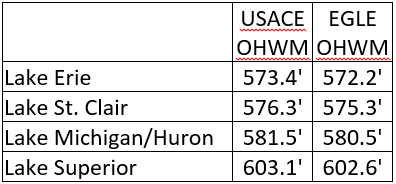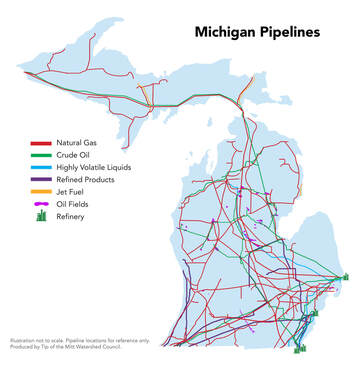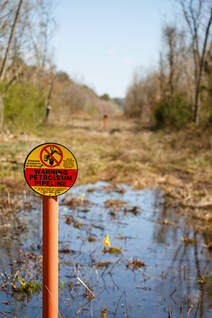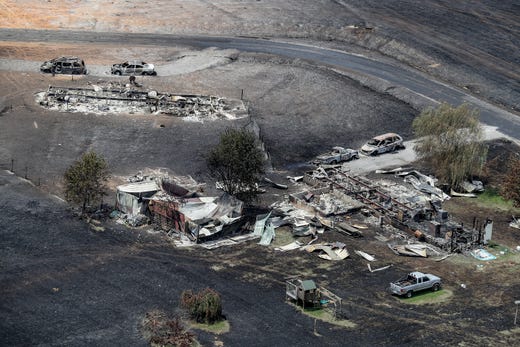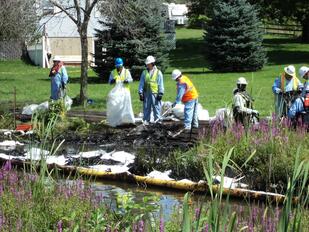Pipeline Siting
Siting of Pipelines by the Michigan Public Service Commission

In Michigan, Public Act 9 of 1929 (Act 9) MCL 483.101 et seq. grants siting authority for natural gas pipelines to the Michigan Public Service Commission (MPSC). Siting authority for crude oil and petroleum product pipelines, and pipelines carrying certain substances consisting primarily of carbon dioxide, is granted under Public Act 16 (Act 16) MCL 483.1 et seq.
Jurisdictional Overlap of Siting
|
Jurisdictionally, there exists regulatory overlap for the pipelines in the State of Michigan between the MPSC and the Federal Energy Regulatory Commission (FERC). Concerning pipeline siting, the MPSC has jurisdiction over intrastate (wholly within the State of Michigan) Act 9 natural gas pipelines and both inter- and intrastate Act 16 liquid pipelines. The FERC holds jurisdiction over interstate (crosses over the boundaries of a single state) natural gas pipeline siting.
|
Ex Parte Cases
Once an Act 9 or Act 16 application is received, MPSC staff review the application and make a recommendation on if it can be handled on an ex parte basis. A determination of eligibility for ex parte treatment requires an application which does not result in an immediate increase in rates for the customers and does not need the right of eminent domain to secure right-of-way. An ex parte proceeding saves time and expense for all parties involved compared to a full contested case hearing process. In ex parte proceedings, MPSC staff work directly with the applicant to review the application. Staff also help draft an order for submission to the MPSC for consideration and final order
Contested Cases
|
Applications for a project which requires new right-of-way acquisition, proposes increases to rates and/or costs to customers, or involves highly developed or environmentally sensitive areas require a formal administrative hearing, beginning with a prehearing conference (applications for other projects may also be evaluated through a contested case). The MPSC, upon scheduling of the prehearing conference, sets forth noticing requirements the applicant must follow prior to the prehearing conference. The applicant is required to provide notice to each landowner from whom it will need to acquire the property rights for the proposed pipeline; as well as to all cities, incorporated villages, townships, and counties which may be traversed by the proposed pipeline. Additionally, the MPSC requires that the notice of hearing be published in daily newspapers in the counties that the proposed pipeline would traverse.
|

During the prehearing conference, the schedule is set, petitions to intervene are reviewed, and public comments are heard. At the conclusion of the prehearing conference, an Administrative Law Judge (ALJ) sets a schedule for the case and rules on any petitions to intervene.
The hearing process proceeds according to the Rules for Practice and Procedure Before the Commission, R792.10401 et seq. After the evidentiary process, which includes the filing and review of testimony and exhibits and an opportunity for cross-examination, the Administrative Law Judge files a Proposal for Decision to be considered by the MPSC for a final decision and issuance of a final order in the case. At any point after an application is filed, you can comment in either written or verbal form. Comments are posted to the e-docket or included in the hearing transcript.
The hearing process proceeds according to the Rules for Practice and Procedure Before the Commission, R792.10401 et seq. After the evidentiary process, which includes the filing and review of testimony and exhibits and an opportunity for cross-examination, the Administrative Law Judge files a Proposal for Decision to be considered by the MPSC for a final decision and issuance of a final order in the case. At any point after an application is filed, you can comment in either written or verbal form. Comments are posted to the e-docket or included in the hearing transcript.
Staff Review and MPSC Decision
|
During a contested case process, staff reviews pipeline siting applications, along with included applicant testimony and exhibits related to the proposed pipeline. Staff then works with the applicant to obtain supplementary information regarding the application and proposal through audit and discovery requests. Throughout the review, staff focuses on the proposed route, project necessity, engineering specifications of the pipeline, and environmental impact concerns to determine its position either for recommendation to the MPSC for approval or disapproval of the proposed pipeline application. Additionally, during the review, should it be determined that the project warrants it, staff will make recommendations to the MPSC related to additional requirements or alternative pipeline routes.
|

In 2012, the MPSC issued an order in docket no. U-17020, which stated, “…the Commission will grant an application pursuant to Act 16 when it determines that (1) the applicant has demonstrated a public need for the proposed pipeline, (2) the proposed pipeline is designed and routed in a reasonable matter, and (3) the construction of the pipeline will meet or exceed current safety and engineering standards.” The MPSC applies similar criteria in Act 9 cases.
 Credit: Marathon Petroleum
Credit: Marathon Petroleum
Act 9 also requires natural gas pipeline operators to submit an application to the MPSC, including a map or plat of the proposed line or lines, showing the dimensions and character, its compressor stations, control valves and connections; an estimate of the cost of the project; an estimate of the proven reserves of gas available for transportation through the proposed line; and an estimate of the anticipated revenue, operating expenses and earnings of the project for a 5-year period. MPSC must make a determination into the necessity and practicability of the transmission line or lines and that such line or lines will, when constructed and in operation, serve the convenience and necessities of the public. In other words, “public convenience and necessity” is demonstrated when an operator proves that the pipeline will provide some kind of benefit to the surrounding community or Michigan as a whole.
Public Participation and Comments

Anyone may attend and participate in the prehearing conference. You may file a petition to intervene in the case within the time frame designated in the notice of hearing, which by rule is at least seven days before the prehearing. Additionally, you may comment on the proposed pipeline application without petitioning for intervention.
If you wish to appear at the hearing to make a statement of position without becoming a party to the case, you may participate after disclosing your identity and interest in the case. You must attend the hearing and advise the presiding ALJ of your wish to make a statement of position. Although your statement of position is not part of the official record, all information submitted to the MPSC becomes public information, and thus available on the MPSC’s website, and subject to disclosure. It is advised not to disclose information during public comments that you wish to remain private.
If you wish to appear at the hearing to make a statement of position without becoming a party to the case, you may participate after disclosing your identity and interest in the case. You must attend the hearing and advise the presiding ALJ of your wish to make a statement of position. Although your statement of position is not part of the official record, all information submitted to the MPSC becomes public information, and thus available on the MPSC’s website, and subject to disclosure. It is advised not to disclose information during public comments that you wish to remain private.
E-Docket System
The Michigan Public Service Commission’s Electronic Docket Filings System (E-Docket) provides for the electronic submission of documents and online access of documents submitted in cases before the MPSC. The E-Docket can be accessed at https://mi-psc.force.com/s/. To electronically file documents, you need to register for a MILogin ID and request access to the E-Dockets application. Searches can also be conducted by filing type, date, filed by, company name, and filing number.
Petitions for Intervention
|
To determine whether a proposed intervenor has established standing, the MPSC has consistently adhered to a two-prong test. Under this test, the intervenor must show: 1) that it has or will suffer an injury in fact and 2) that its affected interests fall within the zone of interest to be protected or regulated by statute or the constitutional guarantee in question.
[I]n Association of Data Processing Service Organizations, Inc v Camp, 397 US 150 (1970), which has been applied to utility matters in Drake v The Detroit Edison Company, 453 F Supp 1123 (WD Mich, 1978). This test requires the prospective intervenor to show: (1) that it will suffer an injury in fact, and (2) that the interests allegedly endangered are within the zone of interests to be protected or regulated by the statute or constitutional guarantee in question. (Drake, supra, pg. 1127.) See, Opinion and Order, In re Michigan Consolidated Gas Company, MPSC Case No. U-10150 (December 8, 1992).
Interest in a proceeding’s outcome is insufficient to support intervention.
The MPSC has further held that a claimed future injury is insufficient to fulfill the injury in fact requirement, finding that to satisfy that component an injury must be real and immediate and not conjectural. (See, Order, In re ZFS Ithaca, LLC, MPSC Case No. U-20198 (November 8, 2018)). |
Permissive intervention has also been granted where a proceeding “raises novel questions and important issues of policy” and the intervenor will “bring a unique perspective” to the case. This may be appropriate if the proposed intervenor’s involvement in the case can provide useful information to the MPSC.
If you wish to intervene and become a party to a case, you need to electronically file a petition to intervene with the MPSC. Petitions to intervene may also be filed using the traditional paper format. Petitions to intervene shall be served upon the applicant along with a proof of service. Your petition to intervene needs to set out clearly and concisely the facts supporting your alleged right or interest, the grounds of the proposed intervention, and the position of the petitioner in the proceeding to fully and completely advise the parties and the MSPC of the specific issues of fact or law to be raised. If affirmative relief is sought, the petition to intervene needs to specify that relief.
The Citizen’s Role in Pipeline Siting
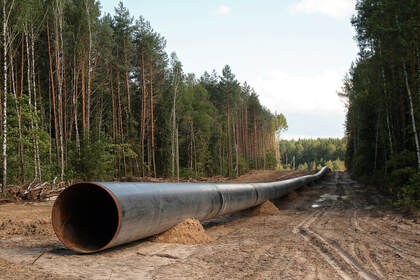
At any point after an application is filed, the MPSC welcomes public comment in either written or verbal form. Comments are posted to the e-docket or are included in the hearing transcript. Public participation is vital in siting of new pipelines. The public, nonprofits, and local governments can provide valuable input on energy needs, community concerns, and environmental considerations. This input will help make decisions that meets the needs of and are supported by the citizens of Michigan.
Step 1 : Understand the application and process
There are important pieces of information of which you need to be aware. These pieces of information include:
1) The case or docket number (this number should be included in any correspondence).
2) The project location and proposed route (this is helpful when trying to identify alternate routes).
3) The type and extent of the proposed activity (this is critical when assessing project impacts).
3) The schedule (this is important for knowing when to comment or intervene in a case).
1) The case or docket number (this number should be included in any correspondence).
2) The project location and proposed route (this is helpful when trying to identify alternate routes).
3) The type and extent of the proposed activity (this is critical when assessing project impacts).
3) The schedule (this is important for knowing when to comment or intervene in a case).
Step 2: Gather information
To be most effective, any individual or group commenting on an application should have first-hand knowledge of the pipeline route in order to determine the potential project impacts. Environmental factors, local zoning ordinances, and public health and safety risks, such as emissions or proximity to vulnerable populations, should be identified.
Step 3: Apply the regulatory standards
|
The effectiveness of your comments will depend upon how relevant they are to the criteria the MPSC has to consider.
For natural gas pipelines, there is no specific definition of “public convenience and necessity.” However, there are a number of factors for you to consider in your comments.
|
There are primarily two questions for the public to evaluate for oil pipelines.
(1) Is there a public need for the proposed pipeline? This requirement is broad and includes a wide array of variables. Liquid pipelines are generally proposed to either replace aging infrastructure, or to satisfy a market imbalance by constructing additional infrastructure. In some cases, both needs may be met by a single project. The “public need” of a project is generally described as the short and long term local, statewide, regional, or national benefits to a project.
(1) Is there a public need for the proposed pipeline? This requirement is broad and includes a wide array of variables. Liquid pipelines are generally proposed to either replace aging infrastructure, or to satisfy a market imbalance by constructing additional infrastructure. In some cases, both needs may be met by a single project. The “public need” of a project is generally described as the short and long term local, statewide, regional, or national benefits to a project.
|
(2) Is the proposed pipeline designed and routed in a reasonable manner? When evaluating what is “reasonable,” the Michigan Environmental Protection Act requires the MPSC to consider:
Environmental impacts that may be associated with construction and operation of a pipeline include tree clearing, interruptions to farming or other land use, waterbody crossings, any other impacts to a previously undisturbed area, and some amount of environmental risk due to the potential for a rupture or spill in the future. |
Step 4: Take Action
|
After answering the questions above, you must determine whether or not to take action by filing comments or petitioning to intervene. If the project has no feasible alternative route, is in the public interest/need, and will have not have an unreasonable threat to public health and safety and the environment, then there is no need for further involvement. However, this is seldom the case. In practically all cases, you can provide comments that improve the decision-making process and overall outcome.
|
Written comments should always indicate the case/docket number as this ensures that the comments will be considered for the appropriate application. Written comments should be straightforward and factual. Opposition to approval or suggestions for modifications should be stated clearly. Comments should include information on environmental impact and statutory compliance, including local ordinances.
Written comments can be sent to the MPSC at the following address:
Executive Secretary
Michigan Public Service Commission
P.O. Box 30221
7109 West Saginaw Highway
Lansing, Michigan 48909
Comments can also be submitted by e-mail to [email protected].
If you want to become an official party to the case, you must file a Petition to Intervene with the MPSC by the date provided in the Notice of Hearing and follow the other guidelines described in the notice. You can refer to the Rules for Practice and Procedure Before the Commission, which can be found at:
http://dmbinternet.state.mi.us/DMB/ORRDocs/AdminCode/1742_2017-066LR_AdminCode.pdf, pp. 45-68.
Written comments can be sent to the MPSC at the following address:
Executive Secretary
Michigan Public Service Commission
P.O. Box 30221
7109 West Saginaw Highway
Lansing, Michigan 48909
Comments can also be submitted by e-mail to [email protected].
If you want to become an official party to the case, you must file a Petition to Intervene with the MPSC by the date provided in the Notice of Hearing and follow the other guidelines described in the notice. You can refer to the Rules for Practice and Procedure Before the Commission, which can be found at:
http://dmbinternet.state.mi.us/DMB/ORRDocs/AdminCode/1742_2017-066LR_AdminCode.pdf, pp. 45-68.
Federal Energy Regulatory Commission Certificates for Natural Gas Pipelines

The Federal Energy Regulatory Commission (FERC) has the authority to grant certificates for the construction and operation of interstate natural gas pipelines. In so doing, a “Certificate of Public Convenience and Necessity” pursuant to Section 7 of the Natural Gas Act is issued. Prior to the certificate, however, a proposed project must undergo an extensive pre-filing and filing process that includes the approval of the route, review of new lines, environmental assessments, and coordination with various other federal and state agencies.

You can make a difference by submitting your specific comments or concerns about the project. Your comments should focus on the potential environmental effects, reasonable alternatives, and measures to avoid or lessen environmental impacts. The more specific your comments, the more useful they will be.
FERC offers a free service called eSubscription which makes it easy to stay informed of all issuances and submittals regarding the dockets/projects to which you subscribe. These instant email notifications are the fastest way to receive notification and provide a link to the document files which can reduce the amount of time you spend researching proceedings. To sign up go to
www.ferc.gov/docs-filing/esubscription.asp.
FERC offers a free service called eSubscription which makes it easy to stay informed of all issuances and submittals regarding the dockets/projects to which you subscribe. These instant email notifications are the fastest way to receive notification and provide a link to the document files which can reduce the amount of time you spend researching proceedings. To sign up go to
www.ferc.gov/docs-filing/esubscription.asp.
|
There are three methods you can use to submit your comments to the FERC:
The FERC encourages electronic filing of comments and has staff available to assist you at (866) 208-3676 or [email protected]. |
Any person seeking to become a party to the proceeding must file a motion to intervene pursuant to Rule 214 of the FERC’s Rules of Practice and Procedures (18 CFR 385.214). Motions to intervene are more fully described at http://www.ferc.gov/resources/guides/how-to/intervene.asp. Only intervenors have the right to seek rehearing or judicial review of the FERC’s decision. The FERC may grant affected landowners and others with environmental concerns intervenor status upon showing good cause by stating that they have a clear and direct interest in this proceeding which no other party can adequately represent. Simply filing environmental comments will not give you intervenor status, but you do not need intervenor status to have your comments considered.

